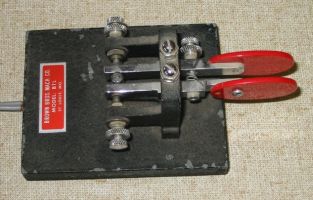Operating an Amateur Radio station using Morse Code
Morse code is in a unique position in Amateur Radio. Once the only mode of communicating messages electronically, it has moved into being just one of many modes available to an amateur radio operator.
The morse code is used to send an interrupted continuous wave signal. This type of signal is technically called a continuous wave (CW). In amateur jargon the term CW is commonly used to refer to the use of morse code and on most radios the mode CW means sending and receiving morse code signals.
But why would an amateur use morse code if s/he could simply talk to people using voice? There are several main situations where morse is still superior to voice.
- In poor conditions, even SSB voice signals sometimes cannot allow a contact to be made, but morse signals may still work.
- where interference is high, a narrower bandwidth can be used on receivers to allow the operator to hear the wanted signal and less interference. Typically SSB receivers have a bandwidth of 2.4 to 3 kHz but morse signals can be heard well in bandwidths as low as 100 Hz. Many transceivers have optional narrow bandwidth filters, or have Digital Signal Processing (DSP) filters that narrow the receiver bandwidth to bandwidths from 500 Hz down to less than 100 Hz.
- Where there are language difficulties for voice contacts, ie. both operators don't speak a common language sufficiently well to be understood, it is still feasible to make a contact using standard codes for commonly required phrases. Examples are "good morning" (GM) and "best wishes" (73), reporting signal strengths with the RST system (a 3 digit number indicating readability, strength and tone quality) .
- For the home builder of radio equipment, a morse transmitter is a much simpler project than a voice transmitter.
- Due to its simplicity a morse transceiver can be made quite small and can require quite low power to operate.
- Morse is still the favoured communication mode for Earth-Moon-Earth contacts made by some radio amateurs. For a number of reasons, the reflected signal heard from the moon is changed or distorted in a way that makes SSB unusable.
For this reason, even the latest radio transceivers include facilities for transmitting and receiving morse code signals, including narrow and variable bandwidth filters and electronic keyers with multiple memory recording and playback facilities.
Morse code is the mode that requires the simplest equipment and lowest power to get a signal from A to B, and it is not hard for the novice to construct a morse transmitter. For this reason, morse is a good mode for portable operation with lightweight gear. The more proficient operators use abbreviations to speed message transfer and normally "read" morse signals in their heads, rather than writing received text onto paper. Seasoned CW devotees operate at speeds of 20 to 30 words per minute, slowing down if signals are poor. They also tend to adjust their transmitters so that they can listen in between letters sent. This feature (called 'break-in' or QSK) is useful if interference crops up, as the receiving station can quickly advise the transmitting station of the interference. 'Break-in' is also good for rapid to-and-fro sessions between operators - similar to VOX on SSB.
Most morse contacts are one-on-one contacts, though morse nets also exist. Perhaps the most successful in Australia is the Sunday morning net on 7.025 MHz. On hearing a CQN call from the net controller on 7.025 MHz, operators call the net control operator and are added to a list of available contacts. The control operator arranges contacts between pairs of stations and allocates a frequency for them to move to, such as 7.015. The pair move off to that frequency and have a brief contact and may return to 7.025 MHz to be paired with another station for another contact. Stations can have as few or as many contacts as they like. There are no long waits (as with some nets that use a single frequency and many participants), activity is spread over the whole band, and stations are spared having to call CQ to get contacts.
Like to hear some morse code? Here is some morse code sending the words "waltzing matilda" (or an MP3 version) at a speed of 20 words per minute. Or a slower speed, here is some text sent at 10wpm using wider letter spacing (MP3 only) to help you read it. These files were created using Winmorse 2 and converted to MP3 using Audacity.
Looking for a good keyer circuit? Try Idiom Press for an excellent keyer, keyer kit or partial kit.
Further information on learning and using Morse can be found here.
Next: AM operation

